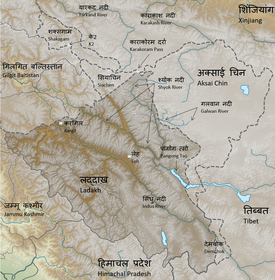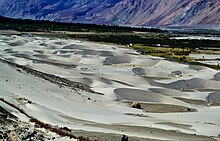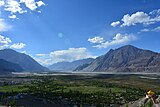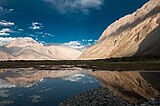
Ladakh is a region administered by India as a union territory and constitutes an eastern portion of the larger Kashmir region that has been the subject of a dispute between India and Pakistan since 1947 and India and China since 1959. Ladakh is bordered by the Tibet Autonomous Region to the east, the Indian state of Himachal Pradesh to the south, both the Indian-administered union territory of Jammu and Kashmir and the Pakistan-administered Gilgit-Baltistan to the west, and the southwest corner of Xinjiang across the Karakoram Pass in the far north. It extends from the Siachen Glacier in the Karakoram range to the north to the main Great Himalayas to the south. The eastern end, consisting of the uninhabited Aksai Chin plains, is claimed by the Indian Government as part of Ladakh, and has been under Chinese control since 1962.

Baltistan also known as Baltiyul or Little Tibet, is a mountainous region in the Pakistani-administered territory of Gilgit–Baltistan. It is located near the Karakoram and borders Gilgit to the west, China's Xinjiang to the north, Indian-administered Ladakh to the southeast, and the Indian-administered Kashmir Valley to the southwest. The average altitude of the region is over 3,350 metres (10,990 ft). Baltistan is largely administered under the Baltistan Division.

Kargil district is a district in Indian-administered Ladakh in the disputed Kashmir-region. It is one of the two districts comprising the Indian-administered union territory of Ladakh. The district headquarters are in the city of Kargil. The district is bounded by the Indian-administered union territory of Jammu and Kashmir to the west, the Pakistani-administered administrative territory of Gilgit–Baltistan to the north, Ladakh's Leh district to the east, and the Indian state of Himachal Pradesh to the south. Encompassing three historical regions known as Purig, Dras and Zanskar, the district lies to the northeast of the Great Himalayas and encompasses the majority of the Zanskar Range. Its population inhabits the river valleys of the Dras, Suru, Wakha Rong, and Zanskar.
Khardung La or Khardung Pass is a mountain pass in the Leh district of the Indian union territory of Ladakh.

Ladakh has a long history with evidence of human settlement from as back as 9000 b.c. It has been a crossroad of high Asia for thousands of years and has seen many cultures, empires and technologies born in its neighbours. As a result of these developments Ladakh has imported many traditions and culture from its neighbours and combining them all gave rise to a unique tradition and culture of its own.

Ladakh is an administrative territory of India that has been under its control since 1947. The geographical region of Ladakh union territory is the highest altitude plateau region in India, incorporating parts of the Himalayan and Karakoram mountain ranges and the upper Indus River and valley.

The Ladakh Range is a mountain range in central Ladakh in India with its northern tip extending into Baltistan in Pakistan. It lies between the Indus and Shyok river valleys, stretching to 230 miles (370 km). Leh, the capital city of Ladakh, is on the foot of Ladakh Range in the Indus river valley.

Tourism is one of an economic contributor to the union territory of Ladakh in Northern India. The union territory is sandwiched between the Karakoram mountain range to the north and the Himalayas to the south and is situated at the height of 11,400 ft. Ladakh is composed of the Leh and Kargil districts. The region contains prominent Buddhist sites and has an ecotourism industry.

The Shyok River is a tributary of the Indus River that flows through northern Ladakh and enters Gilgit–Baltistan, spanning some 550 km (340 mi).

The Nubra River is a river in the Nubra Valley of Ladakh in India. It is a tributary of the Shyok River and originates from the Siachen Glacier, the second-longest non-polar glacier in the world. In earlier Tibetan maps, it was referred as Yarma Tsangpo.

Diskit Monastery also known as Deskit Gompa or Diskit Gompa is the oldest and largest Buddhist monastery (gompa) in Diskit, Nubra Valley of the Leh district of Ladakh. It is 115 km north of Leh.

Turtuk is a village and the headquarters of an eponymous community development block in the Indian union territory of Ladakh. It is a small village sandwiched between the Karakorum Range and the Himalayas, and one of the northernmost villages of India, close to the Line of Control between India and Pakistan. Turtuk is situated in the Nubra tehsil of the Leh district, on the banks of the Shyok River. Geographically, the village is in the Baltistan region, which has been under Pakistani administration, except for five villages of the Turtuk block which are part of India. These villages form the only region in India populated by Balti people. Turtuk is known for its fruit, especially apricots.

Chorbat Valley is a section of the Shyok river valley divided between Pakistan-administered Gilgit-Baltistan and Indian-administered Ladakh. The Pakistan-administered portion is in the Khaplu tehsil of Ghanche District in Gilgit–Baltistan, and the Indian-administered portion is in the Nubra tehsil, Leh district of Ladakh. Chorbat stretches from the edge of Khaplu to the Chalunka village of Nubra.

Murgo, on "Murgo Nala" near Murgo Hotspring, is a small hilly village which lies near the Line of Actual Control in Leh district of the union territory of Ladakh in India, close to Chinese-controlled Aksai Chin. It is one of the northernmost villages of India. The Murgo Gompa is a large Buddhist monastery at Murgo. Murgo lies on the Darbuk–Shyok–DBO Road and Sasser Brangsa-Murgo Road fork of Sasoma–Sasser La-Saser Brangsa-Gapsam-Daulat Beg Oldi Road, both of which connect Leh to Daulat Beg Oldi. The village is inhabited by a small civilian population of Baltis, who make a living by apricot farming and yak rearing. The temperature plummets as low as -30 C in the winters. The weather deteriorates frequently with strong icy winds lashing much of Murgo. Murgo has very little vegetation or wildlife. Telecommunication at Murgo is only available through INMARSAT satellite phones. The Indian Armed Forces have significant presence in the area.
All Ladakh Gonpa Association (ALGA) is the central organisation of the Buddhist monasteries in Ladakh, India. It aims to preserve and strengthen the monastic institutions. It was founded by the 19th Kushok Bakula Rinpoche in 1949 and he acted as its president for 41 years, from 1949 until 1991. In 1949, the first meeting of the great monasteries was held and ten monasteries took part. All Ladakh Gonpa Association was registered in 1959 and is run by a governing body consisting of fifteen lama members belonging to all four major schools of Tibetan Buddhism. There are sixteen major monastic institutions with hundreds of monks in each monastery.
Bogdang is a village in the Leh district of Ladakh, India. It is located in Nubra tehsil.
Tangtse or Drangtse (Tibetan: བྲང་རྩེ, Wylie: brang rtse, THL: drang tsé) is a village in the Leh district of Ladakh, India. It is located in the Durbuk tehsil. Traditionally, it was regarded as the border between the Nubra region to the north and the Pangong region to the south. It was a key halting place on the trade route between Turkestan and Tibet. It was also a site of wars between Ladakh and Tibet.
Durbuk or Darbuk, is a village and the headquarters of the eponymous subdivision and block in the Leh district of Ladakh, India. It is located in the Durbuk tehsil, and falls between Chang La mountain pass and Tangste village on the way to Pangong Tso Lake.

Hundar is a village in the Leh district of Ladakh, India, famous for sand dunes and Bactrian camels. It is located in the Nubra tehsil, on the banks of the Shyok River. The Hunder Monastery is located here.
The Battle of Turtuk was a military engagement between India and Pakistan that took place during the Indo-Pakistani War of 1971. Fighting between the two sides took place in Turtuk and its surrounding areas, then part of the Pakistani-administered Northern Areas in Kashmir. Following this battle, Indian forces captured Turtuk from Pakistan, which had controlled the area since the Indo-Pakistani War of 1947–1948. Per the Simla Agreement, Turtuk was incorporated into the erstwhile Indian-administered state of Jammu and Kashmir, and formally became a part of Ladakh following the revocation of Article 370 by the Government of India in August 2019.
































